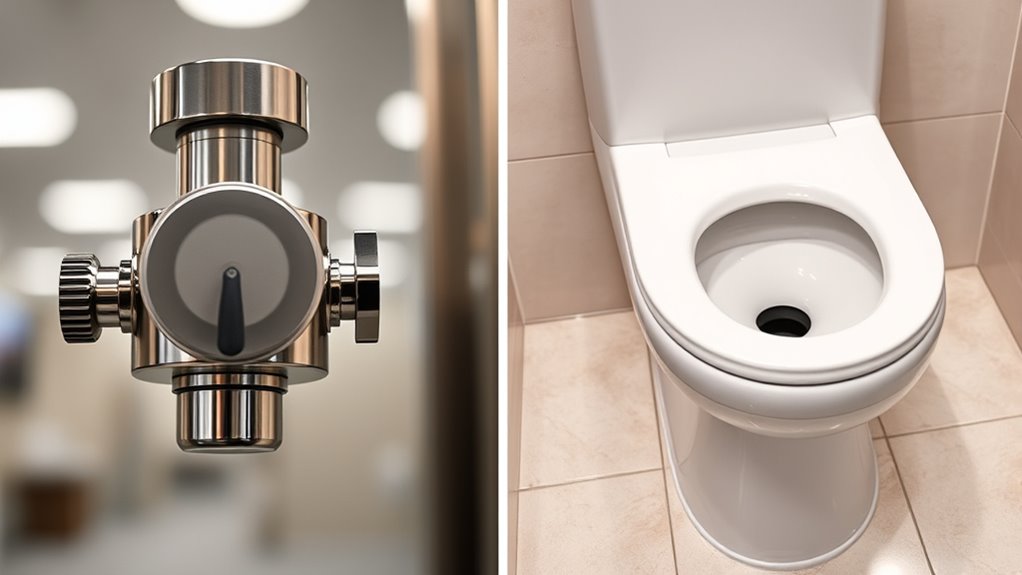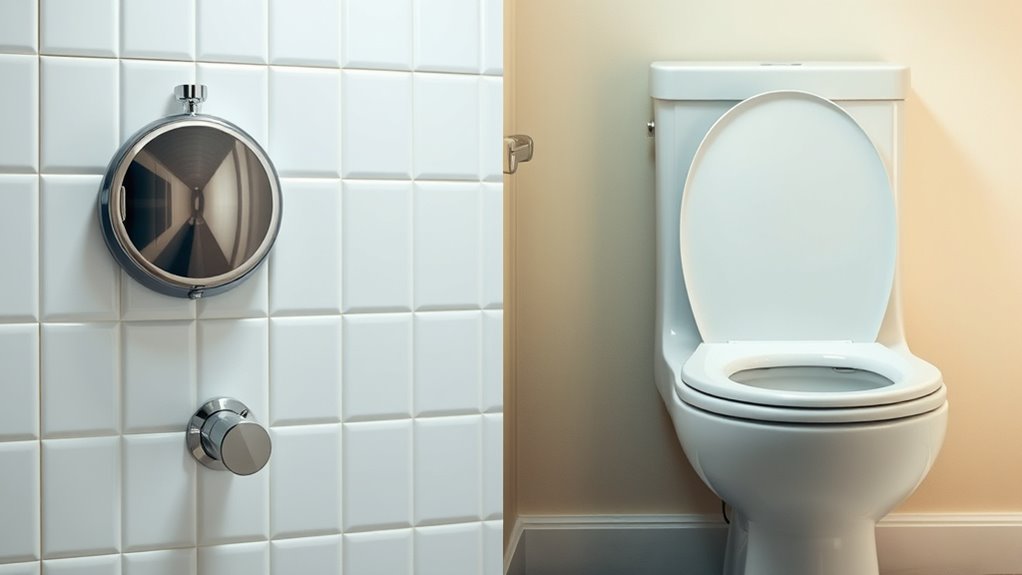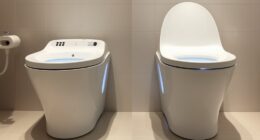If you’re choosing between flushometer and tank toilets, consider your environment. Flushometers are better for commercial spaces with high traffic because they handle heavy use and promote water efficiency. Tank toilets suit residential settings where maintenance is simpler and usage is lower. Both systems have advantages, but understanding their differences helps you select the best fit. Keep exploring to discover more about how these options impact your water costs and maintenance needs.
Key Takeaways
- Flushometer toilets are designed for high-traffic commercial environments, offering durability and quick flushing for heavy use.
- Tank toilets are ideal for residential settings, emphasizing simplicity, ease of maintenance, and lower initial costs.
- Commercial systems with flushometers typically use less water per flush, aiding in water conservation in busy facilities.
- Residential tank toilets generally have fewer mechanical parts, resulting in easier and more affordable maintenance.
- Long-term costs depend on usage, with commercial flushometers requiring more maintenance but providing water savings, while residential tanks favor simplicity.

Have you ever wondered which type of toilet is better for your home or business—flushometer or tank toilet? When choosing between these two systems, it’s important to consider how they impact water conservation and maintenance costs, as these factors can notably influence your long-term expenses and environmental footprint.
Flushometer toilets are commonly found in commercial settings, such as schools, airports, and office buildings, where high usage demands a durable and efficient solution. They operate using a sensor or a manual handle to deliver a powerful, continuous flush directly from the water supply line. Because of their design, flushometer toilets typically use less water per flush compared to traditional tank models, making them a smart choice if you’re aiming to conserve water in a busy environment. This efficiency translates into lower water bills over time, especially when the system is maintained properly. However, you should be aware that the mechanical parts of flushometers, such as the valve and sensor, can require more frequent maintenance to prevent leaks or malfunctions, which could increase overall maintenance costs if not properly cared for.
Flushometer toilets are ideal for high-traffic areas, offering water efficiency but requiring more maintenance over time.
In contrast, tank toilets are more common in residential settings, where water usage isn’t as high and maintenance simplicity is often preferred. These toilets store a specific amount of water in a tank, which is released during each flush. While they tend to use more water per flush than commercial flushometers, many newer models are designed to be water-efficient, helping you reduce overall water consumption. When it comes to maintenance, tank toilets generally have fewer mechanical components and are easier to repair or replace. You can often fix minor issues yourself, and parts tend to be more affordable. This simplicity can lead to lower maintenance costs over the lifespan of the toilet, especially if you choose a model with reliable parts and features designed for longevity. Additionally, advances in water-saving technology have improved the efficiency of tank toilets, making them more comparable to flushometers in water conservation.
Ultimately, your choice depends on your specific needs. If you’re managing a high-traffic commercial space, a flushometer system might save water and withstand heavy use, but you’ll need to budget for ongoing maintenance. For homes or low-traffic environments, tank toilets offer ease of use, easier maintenance, and adequate water efficiency. Weighing these factors carefully will help you select the system that offers the best balance of water conservation and maintenance costs tailored to your situation.
Frequently Asked Questions
What Are the Maintenance Costs for Flushometer Vs Tank Toilets?
When considering maintenance costs, you notice that flushometer systems generally cost more due to their installation complexity and frequent sensor adjustments, especially in high-traffic areas. Tank toilets tend to be simpler, with less frequent repairs, making them more cost-effective over time. Additionally, aesthetic appeal influences your choice; tank toilets offer a classic look, while flushometers provide a sleek, modern appearance, but maintenance varies based on these design factors.
How Do Water Conservation Features Differ Between the Two Systems?
You’ll notice water conservation features differ considerably between the two systems. Flushometers often have advanced water efficiency options, like dual-flush or sensor-activated models, which reduce water use and improve leak prevention. Tank toilets generally use more water per flush but can include low-flow models. Your choice impacts leak prevention and overall water conservation, making it essential to weigh your specific needs for efficiency and sustainability.
Are There Specific Building Codes for Commercial and Residential Toilets?
You should know that building code compliance and plumbing regulations differ for commercial and residential toilets. Commercial spaces often require stricter adherence to plumbing codes due to higher usage, while residential buildings follow more simplified regulations. It is crucial to check local codes to make certain your toilet system meets all safety and efficiency standards. Always consult with local authorities or a professional plumber to confirm you’re complying with all relevant building and plumbing regulations.
Which System Offers Better Durability in High-Use Environments?
Imagine a sturdy oak standing tall amidst storms—that’s what you need for high-use environments. When comparing durability, flushometers shine with their high-use resilience, handling frequent flushes without faltering. They’re built like a fortress, resisting wear and tear in busy commercial settings. Tank toilets, while reliable, may wear faster under constant pressure. So, if durability’s your goal, flushometers are your best bet for standing strong through the busiest days.
Can Retrofit Options Convert Existing Toilets From One System to Another?
Retrofitting options can sometimes convert your existing toilets from one system to another, but you’ll face certain retrofitting challenges. Compatibility issues often arise, making it tricky to switch without significant modifications. You’ll need to assess system compatibility carefully and possibly replace parts or the entire fixture. It’s best to consult with a plumbing professional to evaluate whether your current setup can handle the retrofit efficiently and cost-effectively.
Conclusion
Choosing between flushometers and tank toilets isn’t just about functionality — it’s about feeling confident in your decision, knowing you’ve considered every detail. Whether you’re upgrading a busy commercial space or your cozy home, the right choice brings peace of mind and comfort. Sometimes, the perfect fit appears just when you least expect it, making your everyday routines smoother and more satisfying. Trust your instincts — the right toilet system is waiting to make your space feel just right.










